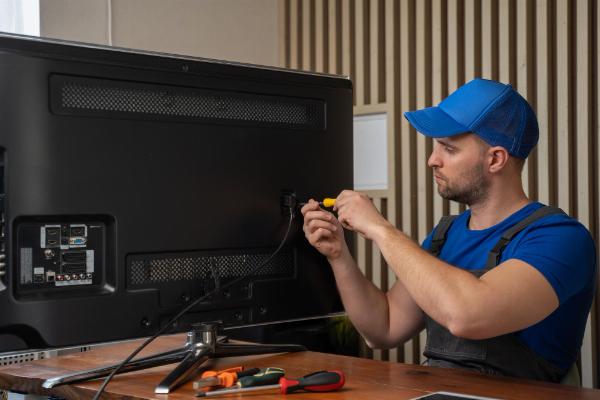What Are the Most Common Issues with LG TVs and How Can They Be Repaired?

Strong 8k brings an ultra-HD IPTV experience to your living room and your pocket.
LG TVs are known for their advanced technology, sleek designs, and top-notch picture quality, making them a popular choice for households around the world. However, like any electronic device, LG TVs are not immune to issues over time. Whether it’s a problem with the display, sound, or connectivity, several common issues can arise with LG TVs. Fortunately, many of these problems can be resolved with proper diagnosis and LG TV Repair services. In this blog, we’ll explore the most common issues with LG TVs and how they can be repaired.
1. LG TV Won’t Turn On
One of the most frustrating issues with any television is when it simply won’t turn on. This is a common problem faced by LG TV owners, and it can be caused by several factors.
Possible Causes:
Power Supply Issues: The most common reason for this issue is a faulty power supply. This could be due to a loose power cord, a faulty power outlet, or internal power board problems.
Remote Control Malfunction: Sometimes, the issue lies with the remote control, not the TV. If the batteries in the remote are dead or the remote itself is malfunctioning, the TV may not respond.
Internal Circuit Issues: If the power supply to the internal circuits fails, the TV may not turn on. This is a more serious issue that could require professional repair.
How to Fix It:
Check the Power Supply: Start by checking the power cord. Make sure it is properly plugged into both the TV and the power outlet. Try plugging the TV into a different outlet to rule out an issue with the socket.
Test the Remote: Replace the batteries in the remote control or try using the power button on the TV itself to turn it on.
Reset the TV: Unplug the TV from the power source, wait for about 10 minutes, and then plug it back in. This can sometimes reset the TV’s internal circuits and resolve the issue.
Professional Repair: If none of these solutions work, there could be a problem with the internal power board, which would require professional repair or replacement.
2. No Picture or Blank Screen
Another common issue with LG TVs is when the sound works, but the screen remains blank or displays no picture. This can be particularly frustrating, especially if the TV appears to be working otherwise.
Possible Causes:
Loose or Damaged Cables: HDMI or AV cables that are not properly connected or are damaged can cause the screen to go blank while the sound continues to play.
Backlight Failure: The backlight is responsible for illuminating the TV screen. If the backlight fails, the screen will go dark even though the TV is on.
T-CON Board Failure: The T-CON board controls the image processing on the TV screen. If this board fails, the screen may go blank.
How to Fix It:
Check the Connections: Ensure that all HDMI and AV cables are securely connected to the TV and any external devices. Replace damaged cables if necessary.
Test with a Different Input: Try switching to a different input source, such as a DVD player or gaming console, to rule out an issue with the input device.
Backlight Repair: If the backlight is the issue, you may notice a faint image on the screen when shining a flashlight on it. Replacing the backlight requires professional assistance.
T-CON Board Repair: If the T-CON board is faulty, the TV may need a replacement part. A professional technician should handle this repair.
3. Sound Issues: No Sound or Distorted Sound
Sound problems are another frequent complaint among LG TV owners. Issues may include no sound at all, low volume, or distorted audio.
Possible Causes:
Muted Sound: Sometimes, the simplest explanation is that the TV is muted or the volume is turned down too low.
Audio Settings: Incorrect audio settings or a change in the sound output mode could lead to sound issues.
Speaker Malfunction: Internal speakers may become damaged over time, leading to distorted or no sound.
External Device Issues: If the sound issue occurs when using an external device (like a soundbar or streaming box), the problem may lie with the device itself or its connection.
How to Fix It:
Check the Volume and Mute: Ensure the TV is not muted and the volume is set to an audible level.
Check Audio Settings: Go into the TV’s audio settings and ensure that the correct output (internal speakers or external device) is selected. You can also try resetting the audio settings to default.
External Devices: If you're using a soundbar or other external audio equipment, check the cables and settings to ensure they are connected properly.
Speaker Repair: If the issue is with the internal speakers, they may need to be replaced. A technician can diagnose and repair the issue.
4. Wi-Fi and Connectivity Problems
Smart TVs, including LG models, rely on a stable internet connection for streaming content and downloading apps. Connectivity issues, such as slow streaming, intermittent Wi-Fi connections, or complete loss of internet, are common complaints.
Possible Causes:
Weak Wi-Fi Signal: If your TV is too far from the router, the signal may be weak, causing connectivity issues.
Incorrect Network Settings: The TV may have incorrect Wi-Fi or network settings.
Software Glitches: Outdated firmware or software glitches can interfere with Wi-Fi connectivity.
How to Fix It:
Restart the TV and Router: Turn off the TV and unplug the router for a few minutes. Restart both devices to refresh the connection.
Move the Router Closer: Ensure that the TV is within range of the Wi-Fi router, or consider using a Wi-Fi extender to boost the signal.
Check Network Settings: Go into the TV’s settings and re-enter the Wi-Fi password to reconnect to the network. Ensure that all network settings are correct.
Update Firmware: Check for any software or firmware updates for your LG TV. Updating the TV can resolve many connectivity issues.
5. Screen Flickering or Lines on the Display
Flickering screens or lines appearing on the display are common visual issues with LG TVs. This problem can range from mild flickering to more severe screen distortions.
Possible Causes:
Loose or Damaged Cables: HDMI cables that are loose or damaged can cause flickering or lines on the screen.
Outdated Firmware: Software bugs or outdated firmware can lead to display issues.
Panel or T-CON Board Damage: Physical damage to the screen or T-CON board may cause lines or flickering.
How to Fix It:
Check the Cables: Ensure that all cables are securely connected and not damaged. Replacing faulty HDMI cables can often resolve this issue.
Update the Firmware: Check for and install any available firmware updates for your TV.
Professional Repair: If the issue persists, the TV’s screen panel or T-CON board may need to be repaired or replaced by a professional technician.
6. Remote Control Not Working
If your LG TV's remote control isn’t working, it can be inconvenient and frustrating, especially if you can’t access the TV’s functions manually.
Possible Causes:
Dead Batteries: The most common reason for remote control issues is dead or weak batteries.
Remote Sensor Issues: The TV’s remote sensor may not be picking up signals due to dirt or malfunction.
Damaged Remote: The remote control itself may be faulty or damaged.
How to Fix It:
Replace the Batteries: Try replacing the batteries in the remote control with fresh ones.
Clean the Remote Sensor: Make sure the TV’s remote sensor is clean and not obstructed by any objects.
Test with a Different Remote: If possible, test the TV with a different LG remote to see if the problem is with the remote control itself. If the remote is damaged, you may need to purchase a replacement.
Conclusion
LG TVs offer a range of advanced features, but like all electronics, they are not immune to technical issues. Some of the most common problems, such as power failures, blank screens, sound issues, and connectivity problems, can often be resolved with basic troubleshooting steps. However, more serious problems, such as backlight failure, panel damage, or internal circuit issues, may require professional repair.
If you’re experiencing any of these issues with your LG TV, it’s important to diagnose the problem accurately and determine whether it can be fixed at home or requires expert intervention. Regular maintenance, including updating firmware and checking cables, can help prevent some of these common issues, keeping your LG TV in optimal working condition for years to come.
Note: IndiBlogHub features both user-submitted and editorial content. We do not verify third-party contributions. Read our Disclaimer and Privacy Policyfor details.


